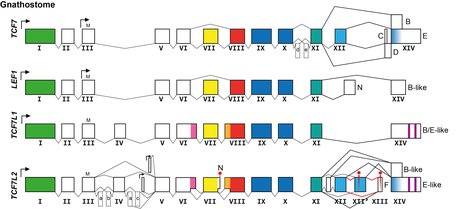TCF/LEF family

The TCF/LEF family (T cell factor/lymphoid enhancer factor family) is a group of genes that encode
History
The discovery of the TCF/LEF genes as nuclear Wnt pathway components in the 90s[7][8] was a pivotal breakthrough for the Wnt signalling research field, plugging an important knowledge gap and enabling subsequent understanding of transcriptional regulation of Wnt target genes, particularly in embryonic development and cancer.
Before this discovery it was only known that upstream Wnt signalling mechanisms regulated the cytoplasmic abundance of the beta-catenin protein, which as a consequence translocated into the cell nucleus. However, since the protein structure of beta-catenin did not reveal any DNA-binding domain, it was still unclear how nuclear beta-catenin could regulate Wnt target genes. Following the discovery, a model was established whereby Wnt signalling-regulated beta-catenin in the nucleus attaches to TCF/LEF DNA binding proteins, which recognise the DNA consensus sequence around the core 'CTTTG', called Wnt Response Element (WRE).[9]
This rule that beta-catenin-TCF interaction on DNA regulates Wnt target gene expression, has nonetheless been broken by examples of Wnt- and beta-catenin-independent functions for TCF/LEF proteins (for instance in zebrafish CNS development
Structure
The structure and function of TCF/LEF proteins explains this bimodal function. TCF/LEF genes encode proteins with an elaborate structure that can however be summarised by considering four main domains:
- N-terminal domain: mediating interaction with transcriptional activatorfunction.
- Control region: includes sequences regulating and mediating the transcriptional repressor function and encoding a transcriptional repressor binding domain for the Groucho family.
- DNA-binding domain: includes a very highly conserved HMG (nuclear localisation sequence).
- C-terminal tail: may contain an additional DNA-binding domain and an additional transcriptional repressor binding domain.[17]
Diversity in TCF/LEF protein structure and function comes from having different genes. Humans and jawed vertebrates generally have four genes encoding TCF/LEF proteins:
- TCF7 (also called TCF1)
- LEF1(also called TCF1α)
- TCF7L1 (also called TCF3)
- TCF7L2 (also called TCF4)
Further diversity comes from expression from the same gene of alternative transcripts encoding different protein isoforms, particularly from the TCF7 and TCF7L2 genes:
- There are isoforms expressed from secondary promoters that encode proteins that lack the usual N-terminus and therefore specifically the beta-catenin binding domain (see above). These protein isoforms function not as bimodal transcription factors but as constitutive repressors, and they are refractory to upstream Wnt signalling regulation.[18][19]
- There are isoforms from alternative splicing in the part of the transcript encoding the control region, which influence the propensity of the encoded protein isoforms to act as transcriptional repressors (without beta-catenin) or transcriptional activators (with beta-catenin).[20]
- There are isoforms from alternative splicing in the part of the transcript encoding the C-terminal tail resulting in protein isoforms with and without the additional DNA-binding domain and resulting in changing the reading frame in which the last exon is translated with or without an additional transcriptional co-repressor binding domain.[21][22]
Function
TCF/LEF proteins function as bimodal transcription factors:
- As described, TCF/LEF proteins act as transcriptional activators in association with nuclear beta-catenin (and transcriptional co-activators attached to beta-catenin);
- but without beta-catenin, TCF/LEF proteins function as transcriptional repressors (attached to transcriptional co-repressors members of the Groucho family).
Thus, as a consequence, Wnt target genes are actively repressed in the absence of Wnt signalling activity, then activated when Wnt signalling actively drives beta-catenin into the nucleus.[23]
TCF/LEF genes support diverse functions in embryonic development, stem cell biology, and in disease.[24][25] Given the conservation of structure, functions of different TCF/LEF genes and proteins are often redundant in many organs and tissues where Wnt signalling is important, yet genetic analysis suggested from the beginning that this redundancy is only partial, suggesting TCF/LEF gene- and TCF isoform-specific functions, many of which are only now beginning to be discovered.
Prominent functions of TCF/LEF genes in embryonic development include vertebrate dorsal axis induction, anterior-posterior patterning of the developing Central Nervous System,
References
- S2CID 246161317.
- PMID 15473860.
- S2CID 2503910.
- PMID 27617575.
- PMID 21247979.
- S2CID 25665021.
- S2CID 4369341.
- S2CID 14324471.
- PMID 23024173.
- PMID 26713625.
- PMID 19655378.
- S2CID 24572861.
- PMID 32808927.
- PMID 29153704.
- PMID 21606952.
- PMID 12727872.
- ISBN 9781118444122.
- PMID 8622675.
- S2CID 28974522.
- S2CID 20515922.
- PMID 17893322.
- PMID 27527215.
- PMID 28649368.
- S2CID 30976795.
- ISBN 9781118444122.)
{{cite book}}: CS1 maint: location missing publisher (link - PMID 10498690.
- PMID 11445543.
- PMID 32403323.
- PMID 18599616.
- PMID 29317436.
- NCBI CDD: cd01388 (SOX-TCF_HMG-box); human proteins
